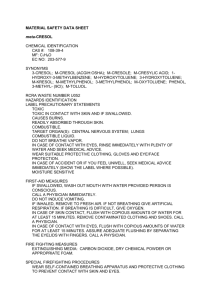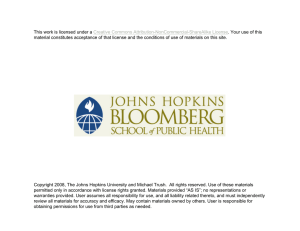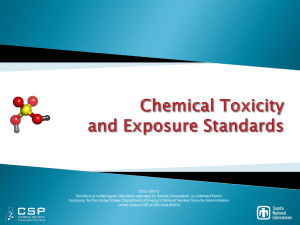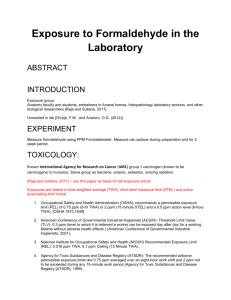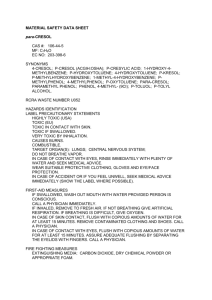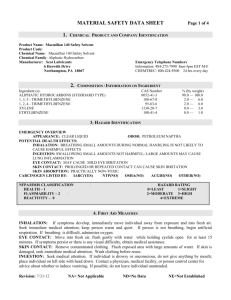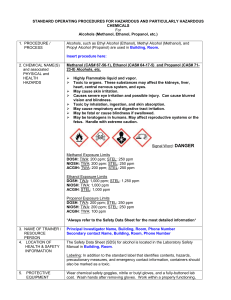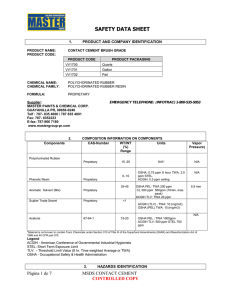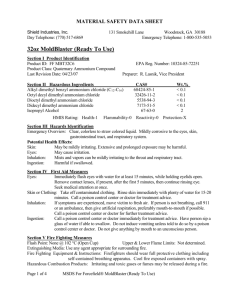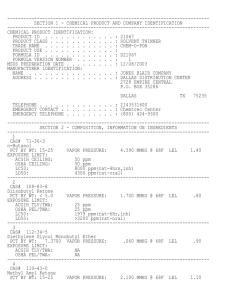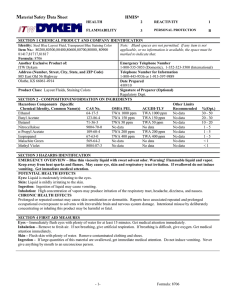EH Terminology
advertisement
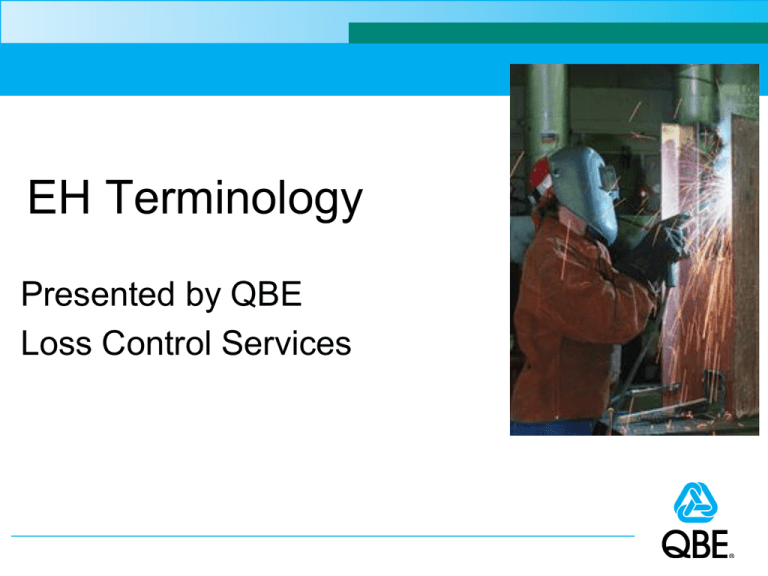
EH Terminology Presented by QBE Loss Control Services Concentration Units • ppm- parts of contaminant per million parts of air by volume. • ppb- parts of contaminant per billion parts of air by volume. • mg/m3- milligrams per cubic meter of air. • g/m3- micrograms per cubic meter of air. • f/cc- fibers of contaminant per cubic meter of air. Parts Per Million (ppm) • Used for gases and vapors • Conversion to mg/m3= (molecular weight)(ppm) 24.45* *24.45 conversion factor at 25°C and 1 atmosphere (760 mm) atmospheric pressure. Milligrams per Cubic Meter (mg/m3) • Used for aerosols • If used for vapors or gases, conversion to ppm= (mg/m3)(24.45*) molecular weight *24.45 conversion factor at 25°C and 1 atmosphere (760 mm) atmospheric pressure. Fibers per cubic centimeter (f/cc) Used for fibrous materials such as asbestos and fiberglass where the length and width of the individual fibers are important toxicity factors. Other Conversion Factors and Definitions • • • • mg- milligram -1/1,000 of a gram g- microgram -1/1,000,000 of a gram 1000 ppb = 1 ppm 1 ppm = 0.0001% Exposure Limits • Time Weighted Average (TWA)- Average concentration of a substance over an 8-hour shift, for a 40-hour week, unless otherwise noted. • Short Term Exposure Limit (STEL)- 15 minute TWA exposure that should not be exceeded more than 4 times per 8 hour shift, separated by at least 60 minutes between exposures. Exposure Limits • Ceiling Limits- The maximum allowable airborne concentration that should never be exceeded even momentarily. • Skin Designation- Indicates that the substance may be readily absorbed through the skin, mucous membranes and eyes in significant amounts and that air sampling alone may underestimate the overall exposure. TWA Calculations TWA=(C1T1+ C2T2+C3T3+…. CnTn) T1+ T2+T3+….Tn Where Cn is the concentration during any time Tn . TWA Example If an employee has an exposure to 25 ppm of acetone for 180 minutes and 10 ppm for 240 minutes, the TWA exposure = (25)(180)+(10)(240) =16.4 ppm 180 +240 Exposure Limits • OSHA (Occupational Safety and Health Administration) • NIOSH (National Institute of Occupational Safety and Health) • ACGIH (American Conference of Governmental Industrial Hygienists) • AIHA (American Industrial Hygiene Association) • Other- Manufacturer’s Recommended Limits OSHA • Permissible Exposure Limits (PELs) • From table Z-1-A in 29 CFR 1910.1000 or 1926.55 Appendix A for construction. • A concentration of airborne contaminant that it is believed nearly all workers may be exposed to, day after day, on an 8-hour time weighted average basis, without adverse health effects. ACGIH • Threshold Limit Values- (TLVs) • The concentrations to which it is believed nearly all employees can be exposed to without adverse health effects. NIOSH • Recommended Exposure Limits (RELs) • A recommended TWA exposure limit for up to 10-hour shifts for a 40-hour work week. • Usually the most conservative exposure limits. AIHA • Workplace Environmental Exposure Levels (WEELs) • Exposure limits developed by the AIHA for agents with no current exposure limits established by other organizations. OSHA vs ACGIH, NIOSH and AIHA • OSHA’s PELs are legal limits for citation purposes. • In many instances PELs are outdated with current toxicological data by 40 years. • ACGIH, NIOSH and AIHA update exposure limits regularly based on most current toxicology. • Complying with PELs will not necessarily prevent occupational diseases. Mixture TLVs • Used to evaluate exposure to multiple chemicals with similar health effects (additive effects). Mixture TLV= C1 + C2 + C3 +…….Cn TLV1 TLV2 TLV3 TLVn Where Cn is the concentration of a substance and TLVn is its exposure limit. • If the mixture TLV exceeds “1”, an overexposure to the combined chemicals exists. Mixture TLVs Example: An employee has a TWA exposure of 400 ppm to acetone (500 ppm TLV) and to 100 ppm MEK (200 ppm TLV). Mixture TLV = 400 + 100 500 200 = 0.8 + 0.5 = 1.3 so there is an overexposure Particle Size • Inhalable Particulate Mass- Hazardous when deposited anywhere in the respiratory tract (<100 µm). • Thoracic Particulate Mass- Hazardous when deposited in the airways and gas exchange region (<25 µm). • Respirable Particulate Mass- Hazardous when deposited in the gas exchange region (<10 µm). Conclusion If you don’t understand an industrial hygiene report, don’t be afraid to ask questions.
